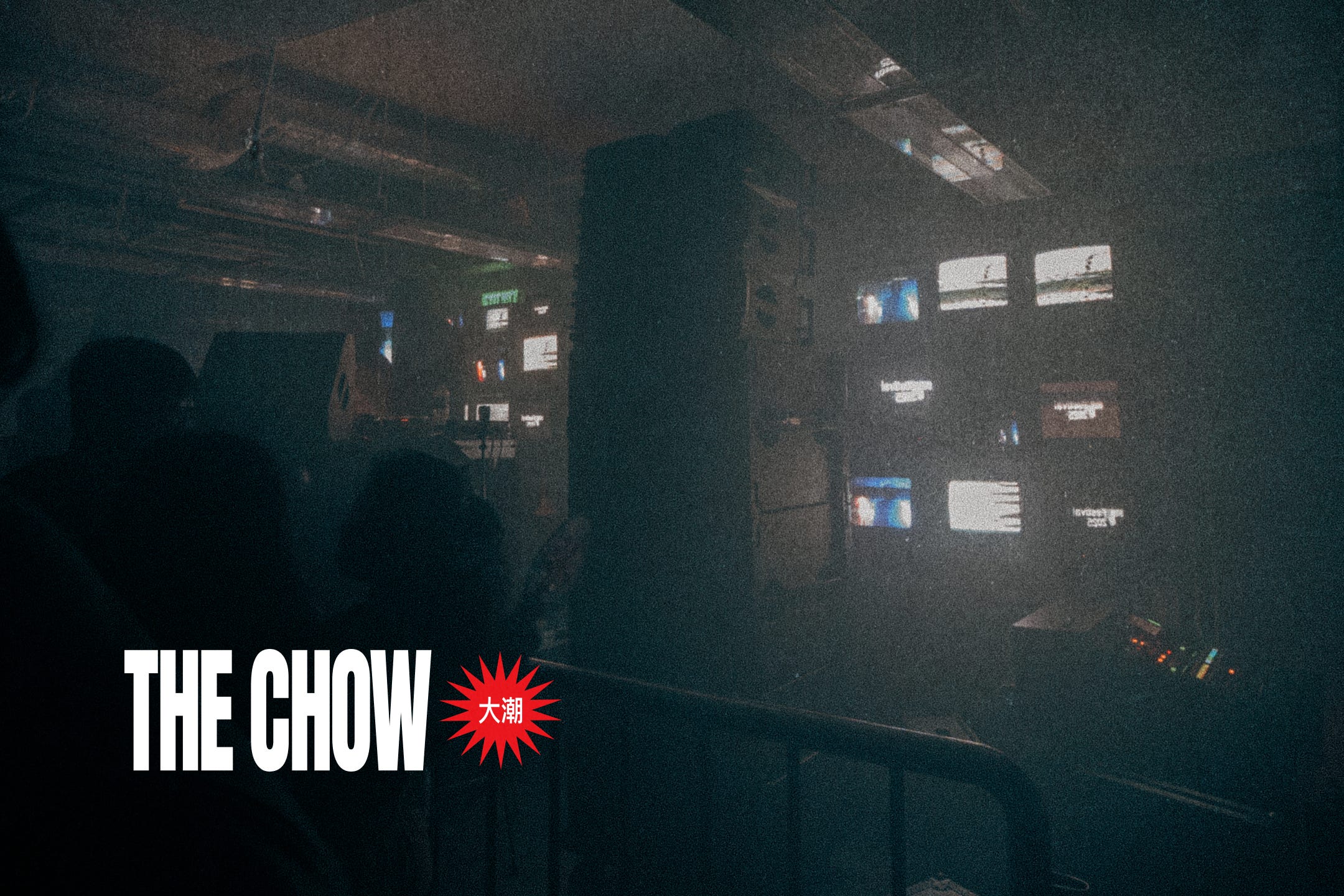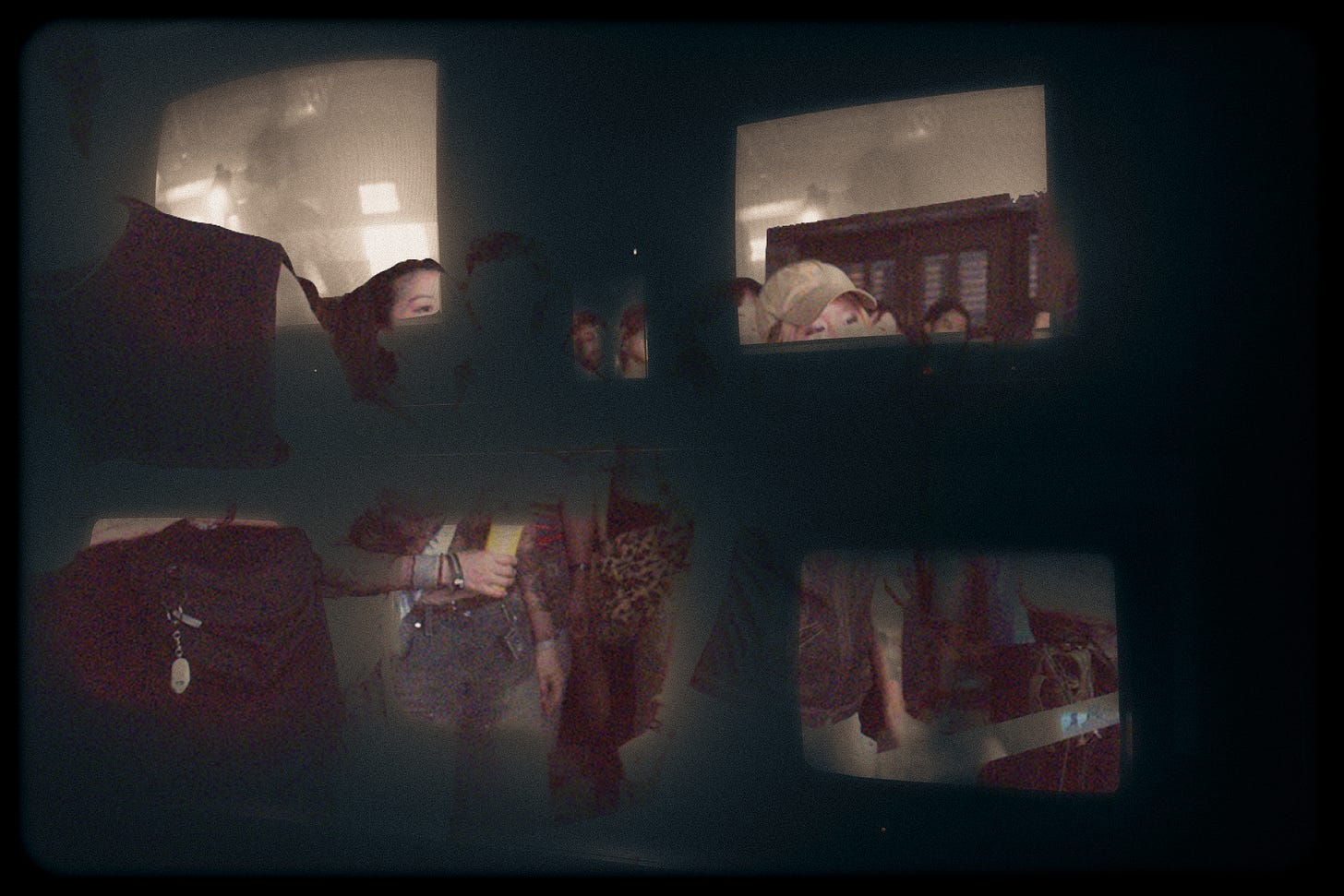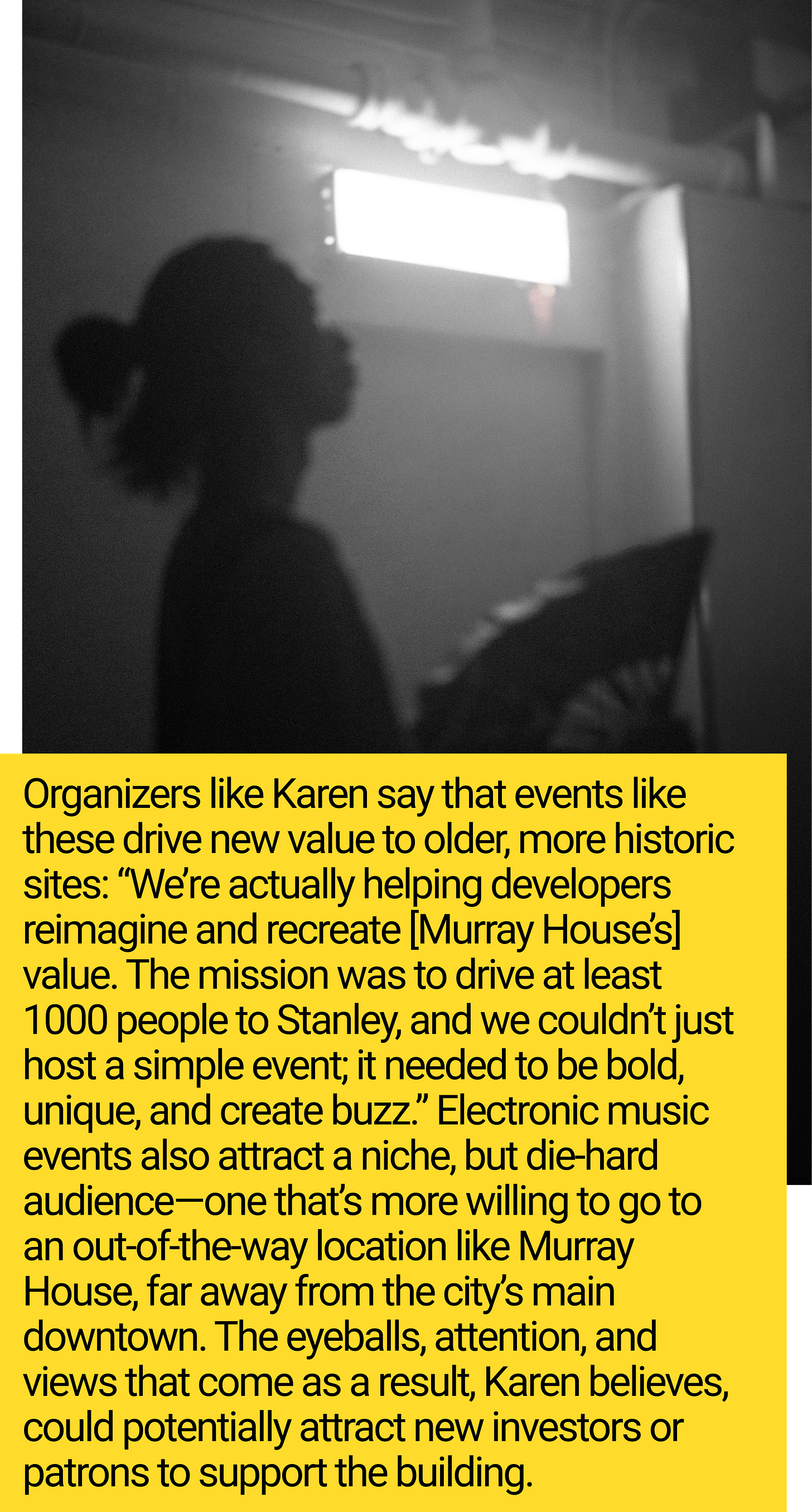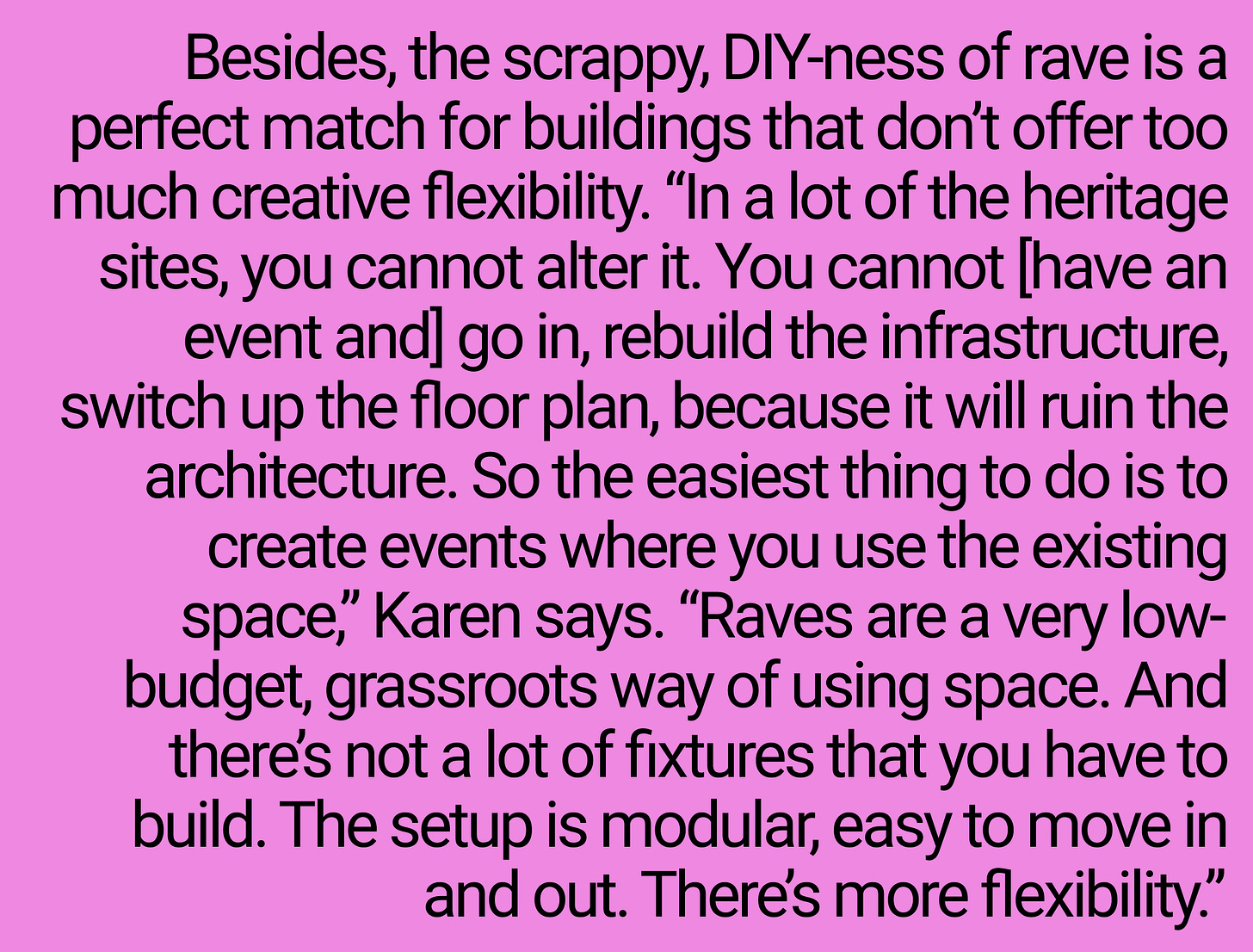Raves at 200-Year-Old Heritage Sites
Digital Zine 1: Across Shanghai, Hong Kong, Singapore, and Manila, electronic music events are being held at historic buildings. How and why did this come to be?
Hey all. I’m sending this newsletter at 7:30pm HKT because I’m visiting New York for a few weeks. This week, I’m experimenting with a zine-in-your-inbox-style format. For the best reading experience, use email or the Substack app to view this article. Enjoy!
Nights out are usually a blur, but this one I’m particularly struggling to remember.
My friend and I pulled out of an Uber on a Saturday evening and began walking by the seaside. Earlier in the week it had typhooned. The storm had subsided but the weather was still moody: Waves tumbled against the rocks along the harbor and the wind still howled. But far louder was the sound of what we were really there for: 01 Festival, an eight-hour rave held at Murray House—the 160-year-old Neoclassical heritage site in Stanley District, on the south of Hong Kong Island.
We approached the bouncer to collect our wristbands. Neon stage lights sputtered from the entrance, flashing along the building’s beige granite walls and checkerboard flooring. At 8pm, the evening was still fresh, but the venue was packed. The main room had reached capacity and a line was already forming to enter. I took two sips of alcohol, ate some fries because I hadn’t yet had dinner, and said “hi” to a few scenester friends catching gusts of wind on the balcony to dry off sweat.
My friend and I rushed into the main room where a pair of bone-thin, Boiler Room-viral Japanese DJs by the name of Minna-no-kimochi were manning the decks, blasting a bright blend of EDM and trance from the speakers. Inside, it was harder to see than usual. Lighting was kept at a minimum, and the heat from the dance floor was clouding my vision. I was but an inch away from the sweaty ravers beside me, and could at most bob my head without touching steaming wet skin. Even with the air conditioning on full blast, the room was a hot and hazy mirage. I left drenched and stinky, with my memory clouded.
That haziness is integral to any late-night experience like this: In her book, Raving, writer and media theorist McKenzie Wark argues that raves exist in “sideways time”: a moment “outside of every other time … without memory or expectations, without history or desire.” Here, you dance as night bleeds into day; the past and future cease to matter—the only thing that does is the present and its thumping bass.
I’m inclined to think that the feeling Wark describes—the collapse of history and future into the present—is elevated when the rave is at a historic building, especially at Murray House, where a dark history still lingers.
Murray House was once a part of the British Army barracks during Hong Kong’s colonial era. Back then, it sprawled along hills in the north of Hong Kong Island. When the Japanese occupied Hong Kong in WWII, Murray House was transformed by the Japanese military police into torture chambers, jail cells, and execution grounds. Inside, a reported 4,000 were killed.
These deaths haunted the building in the decades that followed. Building staff reported being harassed by ghosts. “Some said they had left drawings and blueprints out to dry, only to find them smeared and modified with additional marks,” reports Zolima Magazine. “One worker claimed to have been in the bathroom when he felt something tugging at his sleeve,” even though it was empty. The tenants had enough: In 1974, then-Commissioner of Transport Brian Wilson commissioned 70 Buddhist monks to exorcise the building.
The Murray House of today is also a ghost of its past self. The building’s original granite stone was dismantled in 1982, kept in storage for nearly a decade, and later Frankensteined in the 2000s with construction glue and erected at Stanley.
When these ghosts—the literal ghosts of the building and the history that haunts its walls—collide with alien breakbeats and high-tech synths, the effect is something of a time warp. From the room you could see it: young scenesters in baggy jorts danced with aging expats donning fishnets from the ‘90s. The future and the past were fusing into one.
01 Festival was the collaborative brainchild of Carnaby Fair, a creative agency, and 0159 Events Group, and part of an “intensive 8-month revitalization project” to bring new life to Hong Kong’s southern district: “Stanley’s been empty for quite some time now. And there was an idea [we had] of reimagining Murray House,” says Karen Ng, Director of Carnaby Fair. “I was thinking: how can we really use the space, showcase in a way that doesn’t take away the essence of the architecture, but is still fun and enjoyable?”
Event tickets sold out, in large part due to the concept’s novelty: “[In Hong Kong], nobody had ever done a rave inside a historic building,” Karen adds. “That in itself was a very huge catch, more than a conventional rave near Central.”
Across Asia, there’s also a larger pivot towards hosting electronic music events held inside heritage sites, where high-tech sounds fuse with the iconography and architecture of the past. This year’s Qixi festival saw Alter, a Shanghai-based events group, host a rave inside the historic Yu Garden—live DJ sets, 3D visuals, and flashing lights embellished the 466-year-old landmark. In Manila, UNKWN agency hosted its annual rave in Intramuros last month, playing archipelagic house music inside Spanish-style castles. And as early as 2022, Singaporeans were hosting raves in Haw Par Villa, a cultural heritage site with statues of figures from Chinese mythology. In a BBC report of the event, people were “shedding … skin, seeking release,” “jolting to a thumping bass” beside “topless mermaids, warrior demons and wizened old sages like Confucius.”
But I think you can also explain the Asian urge to rave at a heritage site another way. There’s something about Asia’s shared cultural history tugging on its collective unconscious, that makes raving alongside history make sense.
In no other region of the world, for example, did modernity come at such a breakneck speed. The Asian Miracle quickly transformed Singapore and Hong Kong from fishing villages to financial hubs; Taiwan and South Korea from fascist dictatorships into countries shipping semiconductors and OLED TVs and 16-megapixel cameras to the West.
Likewise, China’s ascendance came a few decades later, but with its rapid upshot into a global superpower, pundits have often called it “The Future.” What might this amount to? In Chinese modernity, as Martin Jacques notes, the past and the future are not discrete categories like in the West; instead, rapid economic transformation compresses time—past and future are squeezed and condensed into the present. “The future is already here—it’s just not very evenly distributed,” William Gibson once wrote. For China, observed the Paris Review in 2018, “that’s true on a meter-for-meter basis.”
You can see this collision of past and future throughout Asia. Buddhist shrines in Singapore sit wedged between high-rise offices and hawker centres; The Bund in Shanghai reflects colonial architecture against a futuristic skyline. And of course, high-tech raves across Asian cities are held at cultural heritage sites, where a sonic future is imagined alongside history.
“It’s quite scary for older generations to accept new concepts. But creativity brings no harm,” she adds. In Asian cities where tradition and modernity so effortlessly collide, Karen believes that creatively combining the new with the old is how we ought to usher in the future:











Awesome and "the weather was still moody" 👌
So good Patrick!!